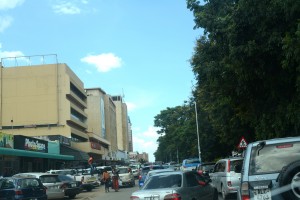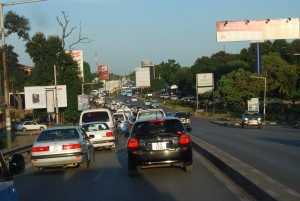by
Mwizenge S. Tembo, Ph. D.
Professor of Sociology
Introduction
I had just finished shopping at the Downtown Shopping Mall on the South-End of Cairo Road around the Kafue Round About. I turned left heading South to Kafue but I was going to Manda Hill on the Great East Road. I had to turn right at the robots toward Lumumba Road. I didn’t want to go to Lumumba Road because I knew there would be more traffic congestion. The U- Turn back toward Cairo Road was wide open. As soon as I made the U- Turn into an unusually wide open lane, I knew I was in deep trouble when a Traffic Police Officer stopped me immediately. He politely told me I had broken a traffic code as I was not supposed to make a U-turn. My protesting that I did not see any big visible “no U-Turn” sign did not change the officer’s mind. I was invited to the back of a make shift police station at the back of a van where I paid the fine.
Driving in Lusaka is any driver’s worst nightmare. There is congestion night and day in virtually all parts of the city. Cairo Road is probably the worst. It took me over 30 minutes to drive from Katondo Street across to the Main Post Office. If I had walked, it would have taken me may be 5 minutes.
A “Zambian Watchdog” article of May 2011 has a head line that says: “Traffic Jams and used cars terrorize Zambia’s Roads”. Another article by Kelvin Kachingwe in UKZambians web page in February 2008 said: “Lusaka becoming auto jungle – 50 vehicles per day are being imported”. It is estimated that 300 used cars are being imported into Zambia every day.
In spite all the traffic congestion, to be fair, I never saw any traffic accident in the two weeks I drove in Lusaka last month. Drivers help each other out and every driver negotiates incredibly tight space leaving mere millimeters between vehicles which often may raise one’s temperature and levels of anxiety. Is there a solution to the traffic nightmare and gridlock in Lusaka? There are two possible solutions: first an underground train system and second a new massive sophisticated road highway system around Lusaka. Doing nothing or just building more side roads are not best solutions in the long run.
Underground Tunnel Train System
Lusaka should have 5 major underground train tunnels. The first train tunnel should be from the round about going to the Kenneth Kaunda International airport near Chelston on the Great East Road all the way to Cairo Road. The second underground train tunnel should start from Zanimuone or Landless Corner on the Kabwe or Great North Road all the Way to Cairo Road. The third train tunnel should start from Bauleni, Mtendere, partially under Independence Avenue, under the current Intercity Bus Terminal and Railway station, and finally connect to Cairo Road between Churchhill Road and Independence Avenue. The fourth train tunnel should start from Munda Wanga Botanical Gardens along Kafue Road all the way to Cairo Road. The fifth train tunnel should start from Chilenje and Chilenje South extension through Kabwata, and Kamwala Shopping Center under the Independence Avenue flyover bridge into Cairo Road. The whole area underground between Cairo Road, Cha-Cha-Cha Road, and Freedom Way should have a massive underground railway station where all the trains form the City will interchange.
Sophisticated Road Highways
If the underground tunnel is deemed not possible or too expensive, Lusaka should have a sophisticated road highway system. Four lane highways should be constructed on elevated massive pillars on top and along the five major current road arteries as described already; on the Great East Road, Independence Avenue from Mtendere and Bauleni, from Chilanga on the Kafue Road, and from Zanimuone on the Great North Road all leading to and some highways bypassing above Cairo Road. We cannot afford to have any major roads on the ground anymore as construction has used up all the ground space in Lusaka. These highways would be high speed expressways where there would be no stopping allowed. Slower cars and other limping vehicles would use the current ground roads underneath the elevated highways on massive pillars. The Highway Traffic Officers would enforce the new rules.
Advantages and Benefits
All of these recommendations if implemented would ease road traffic congestion in most parts of Lusaka, save billions of Kwacha in money spent on petrol by thousands of idling vehicles that are caught in perpetual traffic jams. The life spans of the vehicles would be extended. People would sleep better as they would not have to wake up very early to drive to work which would lower costs of medical conditions that happen due to stress. The flow of commerce in the city would be improved.

